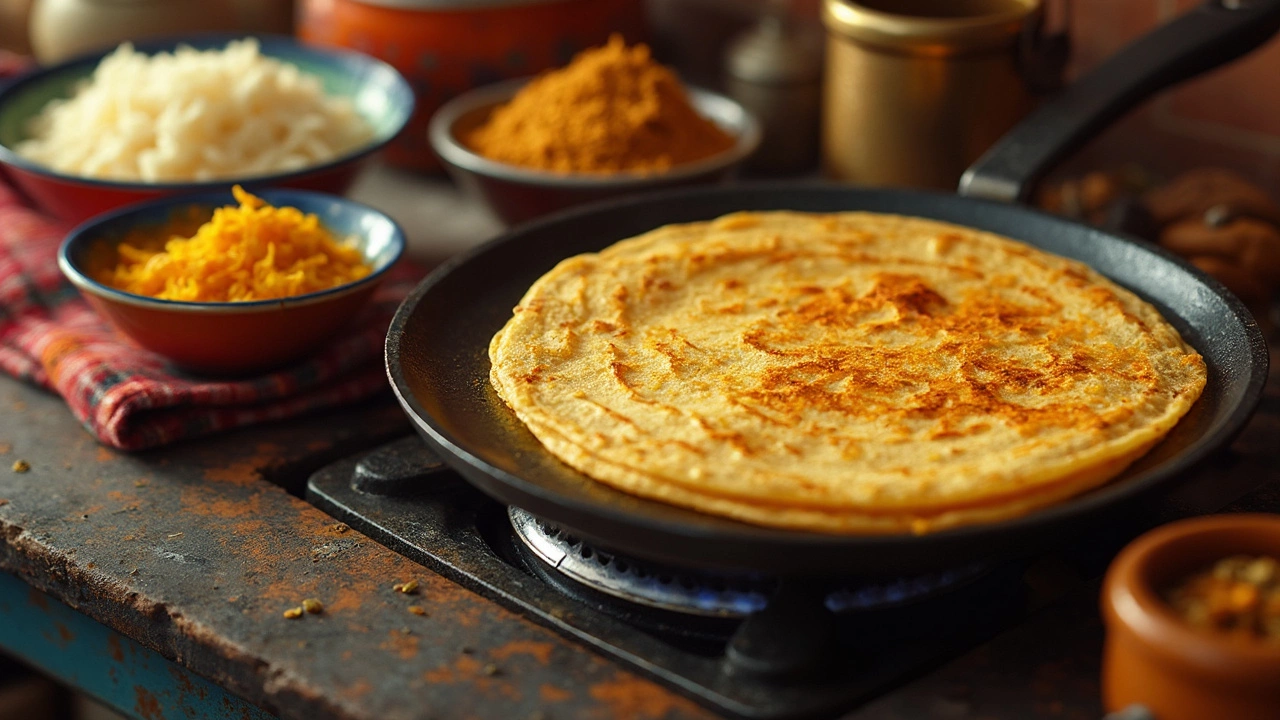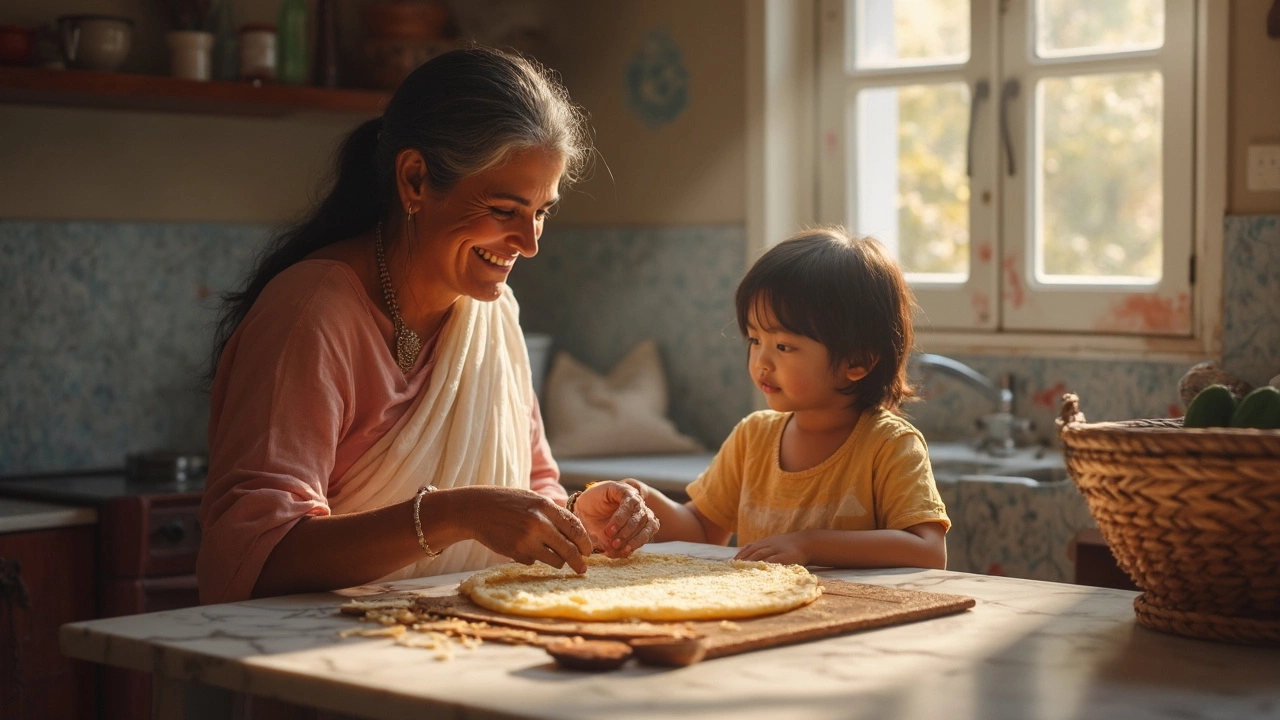What Happens When Extra Urad Dal Joins Your Dosa Batter
27 March 2025

Thinking about adding more urad dal to your dosa batter? You might be onto something exciting! For those who don't know, urad dal is the key to that perfect dosa, often giving it that fluffy, tender texture everyone loves. But before you dump extra scoops into your mix, let's chat about what really happens.
Firstly, upping the urad dal can make your dosas turn out fluffier. Sounds great, right? But here's the kicker—it can also change the taste and overall texture. If you love that classic dosa crispness, be careful not to go overboard. You're walking a fine line between fluff and mush!
- Understanding Dosa Batter Basics
- Role of Urad Dal in Dosa
- Effects of More Urad Dal
- Balancing the Ingredients
- Nutritional Impact
- Practical Tips for Experimenting
Understanding Dosa Batter Basics
To nail making dosa, you gotta start with the right dosa batter. It's all about getting the ratio of rice and urad dal just right, usually a 3:1 ratio does the trick. This means for every three cups of rice, you'll use one cup of urad dal. But let’s get into the specifics.
The rice you use usually falls into two types: regular short-grain rice and parboiled rice. Some folks even add a touch of poha or flattened rice to up the fermentation game. A great batter is well-fermented because, trust me, a bit of tang takes your dosa from good to wow! Expect to let it ferment overnight or up to 12 hours in a warm spot.
- Rice: Provides structure and crispness. Use a mix of regular and parboiled rice for the best results.
- Urad Dal: Responsible for fluffiness and is the hero of the binding process.
- Methi Seeds: Optional but helps in both fermentation and adds a slight flavor punch.
Once you've soaked everything separately for a few hours, it’s grind time. The trick is to gradually add water while grinding, especially with your urad dal, to get a smooth and bubbly texture. Think pancake batter but lighter!
| Ingredient | Purpose |
|---|---|
| Rice | Crunchiness and volume |
| Urad Dal | Fermentation and texture |
| Methi Seeds | Fermentation boost |
So there you go, the perfect dosa starts with a killer batter. Once you’ve got this down, all the other stuff like flipping and filling is way easier.
Role of Urad Dal in Dosa
Urad dal is like the secret ingredient that makes or breaks your dosa batter. It's not just in there for fun—this tiny lentil does a lot of heavy lifting to give you that perfect dosa experience. So, what's all the fuss about?
First off, urad dal is responsible for the fermentation magic in your batter. This means it helps the batter rise and ultimately determines the texture and lightness of the dosa. Without enough urad dal, you might end up with a flat, sad-looking pancake instead of the crispy delight we're aiming for.
Thanks to the protein and starch content in urad dal, it binds the batter together, creating that crucial elasticity. This is why your dosa doesn't just fall apart while picking it up. But there's more to it than just physical properties. The fermentation process also brings out a mild sour flavor, adding a subtle tang to your dosa batter, which enhances its flavor profile.
- Fluffiness and Texture: More urad dal means a fluffier interior but remember, it's all about balance to keep the right crispy texture.
- Fermentation Catalyst: Its presence accelerates the fermentation process which is key for the batter's success.
- Nutritional Boost: This little lentil is packed with proteins that add nutrition to your meal.
Most dosa recipes call for a rice to urad dal ratio of around 3:1 or 4:1. But if you're adjusting this, like adding more urad dal for extra fluffiness, keep an eye on the consistency of the batter. You might need some adjustments here and there to nail that perfect dosa.
Effects of More Urad Dal
So, what happens when you add more urad dal to your dosa batter? The most noticeable impact is on the texture. With extra urad dal, you're likely to end up with a batter that's creamier and denser. This means your dosas could be fluffier and more tender, which many find irresistibly good, especially if you enjoy a softer dosa over the crispy variety.
Why does this happen? It's all about the smoothness and fermentation power of urad dal. Its natural ability to trap air makes the batter rise when left to ferment, leading to a lighter dosa. But there's a catch: go too far, and you risk making your dosas lose the crispy edges people often crave.
There's also a change in taste. More urad dal subtly shifts the flavor, adding a hint of earthiness. While this can enhance the complexity of the dish, it's important to balance it so it doesn't overshadow the mild tang of fermented rice.
If you're feeling brave enough to experiment, remember to adjust other ingredients accordingly. The traditional dosa ratio is around 3 parts rice to 1 part urad dal. If you’re tweaking, try a 2:1 ratio and see how it affects your batter. Keep in mind that more urad dal will take slightly longer to ferment due to the thicker consistency.
| Ingredient | Traditional Ratio | Adjusted Ratio |
|---|---|---|
| Rice | 3 parts | 2 parts |
| Urad Dal | 1 part | 1 part |
Watch out for batter consistency too; it shouldn’t be too runny nor too thick. If needed, throw in a splash of water to loosen things up a bit. This way, even if you have more urad dal, you keep that perfect spreadable consistency.

Balancing the Ingredients
Crafting the perfect dosa batter means getting that rice-to-urad dal ratio just right. While a traditional recipe calls for about 3 parts rice to 1 part urad dal, tweaking these ratios can lead to some interesting and tasty results.
If you're inclined to add an extra pinch of urad dal to your batter, remember, balance is key. Going heavy-handed on the dal can lead to overly dense dosas, which might not cook evenly. Consistency is critical, especially if you're aiming for a certain texture.
Think of it like this: More dal means thicker batter, and that calls for longer fermentation time. The usual 8-10 hours might not cut it. A slow rise can help break down those legumes further, resulting in a better mix. Patience really pays off here.
Cooking tip: If the batter seems too thick, a little water can be your friend. Start by adding small amounts until you hit consistency gold—a thick enough batter that coats the back of a spoon without being goopy.
Another nifty trick: add a handful of poha (flattened rice) into your rice soaking phase. It lends a touch of softness to your dosa without altering the taste much. Texture upgrade, anyone?
Oh, and for those who love a bit of number play, here's a rough guide:
| Ingredient | Usual Ratio |
|---|---|
| Rice | 3 parts |
| Urad Dal | 1 part |
With experimentation, consider moving to something like 2.5:1 if you're aiming for fluffier results but want to avoid compromising on that beloved crispy edge.
Nutritional Impact
Adding more urad dal to your dosa batter isn't just about changing taste and texture—it's also about boosting nutritional value. Urad dal is a powerhouse of protein, which is fantastic news if you're looking for a fulfilling, energy-packed breakfast.
So what's inside urad dal that makes it so good? Well, besides protein, it's got plenty of dietary fiber. Fiber helps keep you full longer, which might stop those mid-morning snack cravings. Plus, it's great for digestion—no one wants to feel sluggish, right?
Here's something you might not know: urad dal is rich in iron. Iron is crucial for making red blood cells and keeping your energy levels up. If you're running on low iron, adding more urad dal could help pick you up. And let's not forget about magnesium—a mineral crucial for many functions in the body.
Here's a quick look at what's inside 100g of raw urad dal:
| Nutrient | Amount |
|---|---|
| Protein | 25g |
| Fiber | 18g |
| Iron | 7.5mg |
| Magnesium | 138mg |
But don't forget balance is key. Too much urad dal might make your dosas heavier, and it's easy to overdo on calories if you're not careful. Also, if you're trying to cut carbs, remember that rice is the main source there—so think about how much rice you want to keep in the mix.
So, there you have it! A little tweak here and there, with more urad dal in your recipe, can lift your breakfast game and keep you fueled throughout your day.
Practical Tips for Experimenting
Diving into dosa experimentation can be fun and rewarding, especially when it comes to tweaking the dosa batter with extra urad dal. Here are some straightforward tips to help you nail it.
First things first: start small. When adding more urad dal, begin by increasing it by no more than 10-15% of the original quantity. This way, you avoid overwhelming the batter, which could mess with the rise and texture.
- Soak and Grind Separately: Always soak your urad dal and rice separately before grinding them. This helps in maintaining the right consistency.
- Fermenting Time: Adding more urad dal might change fermentation time. You may need extra hours to get the batter perfect, but make sure it doesn't over-ferment. Look for a slightly airy and bubbly batter.
- Adjust the Water: With more urad dal, keep an eye on consistency. Add water gradually during grinding until you reach a smooth, thick, and flowing texture.
Feel like getting a bit geeky with it? Watch out for weather changes. Dosa batter ferments faster in warm climates and slower when it's cold, so you might need to factor in your kitchen temperature.
| Factor | Impact |
|---|---|
| Added Urad Dal | Increased fluffiness, but possible reduced crispiness |
| Extended Fermentation | More tangy flavor |
Remember, practice makes perfect. Take notes each time and tweak as needed until you get the batter that brings all the elements you love in a dosa! Stick to these tips, and you're on your way to mastering your own unique dosa batter recipe.